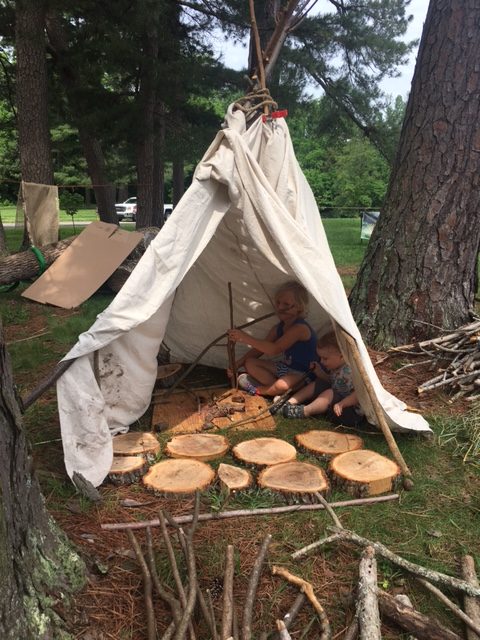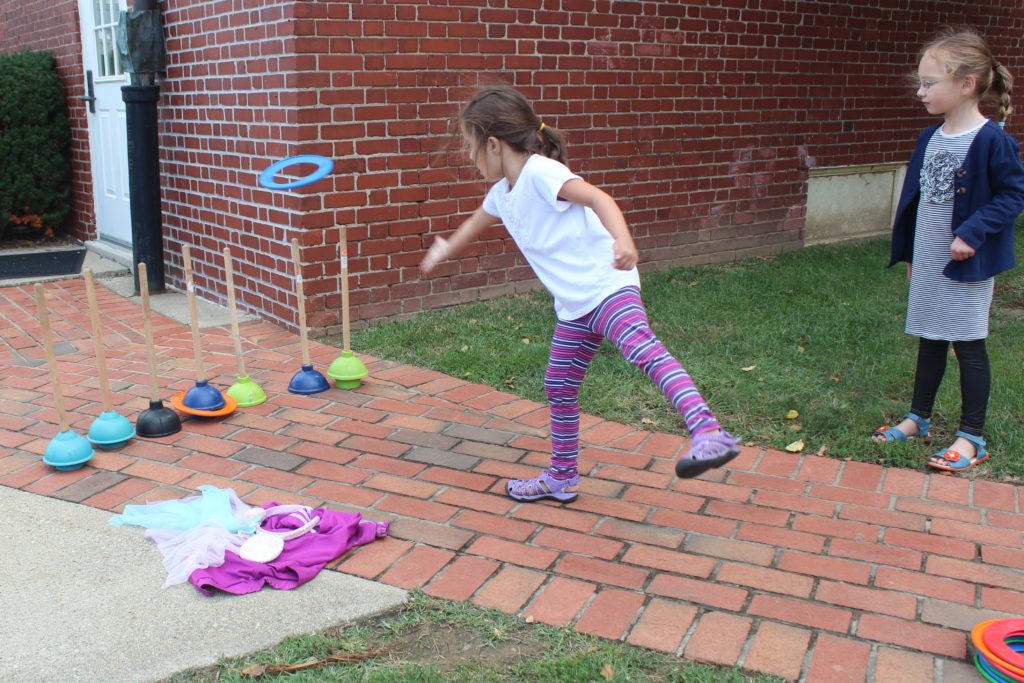
Gathering Loose Parts for Free Play
Unlike many forms of play, free-play demands that the play environment itself be free. It requires things that are unbolted, free to wander, scattered, unkempt…open to possibility. Ultimately it is the difference between creating environments where children play WITH things as opposed to places where children play ON things. That quality of looseness opens up opportunities that are valuable to child development but it also demands more of the adults that provide or care for such environments.
There is an art to creating such spaces and no single solution for how to go about fostering that art. Because the Children at Play Network has a bias toward nature-based outdoor play that bias flows through to how we go about provisioning for free play. This blog post shares some of the knowledge we have gained through our history of offering transportable free play opportunities.
Always Adapting – Learning Through Practice
Most of our go-to kit of loose parts has evolved to include supplies that:
- Have high play value – the children love them
- Are locally available
- Have benefit greater than the cost
- Are either durable or fit into our ethic for consumables
- Fit within our aesthetic for naturalness
- Are fairly easy to set up and clean up
- Are transportable within our capacity (which is either a 15 passenger van or pickup)
- Are storable within our capacity for storage
Our Top Five Loose Parts – The All Stars of our Free Play Team
Cardboard Boxes

The age old story is true. The box the toy came in is more fun than the toy. Why? Because there is often more open-ended possibility in a box than there is in a toy. Here are some thoughts about boxes in a play environment:
- Quantity matters. But quantity is relative to the size of the environment and the number of players.
- Size matters. Larger boxes, or at minimum boxes that the player can fit within, seem to be more valuable than small boxes. But lots of small boxes can compete with a large box.
- Freedom to manipulate the boxes is critical. Consider each box a consumable that will go away at the end of the play day. You may and you may not be able to salvage boxes at the end.
- Type of cardboard is important. Regular brown corrugated cardboard is easy to draw on. Slick cardboard isn’t as easy to draw on.
- How you initially arrange the boxes has an effect on how children play with them. Group them in large clusters. Consider several different clusters. This will all change as the play day progresses. Also consider what other supplies you put in proximity to the boxes.
- Boxes can be scavenged or bought. We do so many play days that we now buy boxes. When we estimated how much time and effort it took to scavenge boxes we found it to be cheaper to simply budget for them. But we still do both. We prefer the aesthetic of plain brown boxes void of any product information or color.
- Plan for what to do with the spent boxes. We get all of ours to recycling.
- Plan for how to manipulate the boxes. That would include tape, chalk and box cutters.
(More about working with children and boxes are fodder for their own blog post.)
Canvas Tarps

Tarps come in all sizes and all materials. The CAPN gravitates toward unbleached canvas painters tarps. We typically have six to twelve tarps available in different sizes and geometries. We prefer canvas to plastic tarps in order to keep within our aesthetic of natural materials and because children seem to be attracted to the feel of cotton over plastic. Here are some thoughts about canvas tarps in the play environment:
- Tarp sizes should be matched to the size of the children. Larger children seem to like the larger tarps and smaller children the smaller ones.
- You can often purchase canvas tarps at painters supply stores. But call ahead because some only sell plastic versions.
- Tarps work best when used in conjunction with poles, ropes, boxes, clips or other strategies for attaching them or draping them.
- When setting up a play environment don’t simply drop a stack of tarps on the ground. Spread them out or possibly over things. Folded up tarps are often interpreted by children as out-of-play.
- If you drape a tarp over a piece of fixed play equipment it immediately transforms that equipment into something new and different.
- Tarps can also be used to define a play area or as a stage for smaller loose parts.
- Children seem to really like tarps for how they can be used to create a hiding spot.
Ropes – String – Tape

These items are play objects in their own right but they are also used to extend the play value of other things such as boxes and tarps. Here are some thoughts about these items:
- All of these things can become a tangled mess but there are ways of dealing with that. In a worst case scenario, purchase items that can be tossed when they become too tangled.
- Provide rope and string in both short and longer sections. Be careful that they aren’t too long. Young children prefer shorter pieces they can easily manipulate and older children like the greater possibilities that come from longer pieces.
- All of these items can potentially become choking hazards. When providing these objects the responsibility of adults is two-fold: 1) Provide the right amount of assistance when children are first learning about ropes, and 2) Keep a watchful eye out in spite of any assistance.
- Be clear that ropes are allowed to be tied around objects but they are not allowed around people.
- Ropes are available in all kinds of materials. The CAPN gravitates toward cotton string and natural fiber ropes because of our natural materials aesthetic.
- Depending on what type of rope or string you provide you may need to consider how to prevent them from unraveling.
- Have cutters on hand, including bandage cutters, to extricate ropes that accidentally get tied around things with knots that can’t easily be undone.
- Not all tape is created equal. The CAPN prefers a type of brown paper box tape because it can be torn without a tool, it’s brown and fits our aesthetic, it doesn’t leave a gummy mess. We stay away from duct tape entirely.
Sticks and Poles

Children have a natural affinity to sticks. In combination with things to prop them against, rope to tie them together, or tape to affix them to other things with they are full of potential. Here’s some stick thoughts:
- Sticks come in all sizes and can include things such as purchased 2x2s or pvc pipe. But the best is the good old fashioned branch of a tree.
- Small sticks for small children and larger sticks for larger children
- Parents and teachers often say they have problems with sticks because they get used as swords and weapons. That’s true, but in our experience it’s not a big problem with a bit of attention. Sometimes adding MORE sticks solves that problem. One stick is a sword. One hundred sticks is a potential fort.
- Not all sticks are created equal. They should be sound (not rotten) and of lengths that make them usable for making things. Sticks with forks in the end are easier to prop together than straight sticks. Art is in the detail.
- Sticks are often simply a natural part of the play environment. But in most cases planning out your stick supply tends to be better than relying on chance.
- Sticks are hard to store and keep provisioned. Part of a play event can be enlisting children to stack the sticks at the end for the play team to tie into bundles.
- In the Louisville area a GREAT source for really cool sticks is in the area between the railroad bridge and the Falls of the Ohio park.
- You can buy 2x2s and pvc pipe at almost any home supply store. At the end of the day bundle them up with tape or twine to make them easy to move and store.
One Hundred of Almost Anything

Sometimes the trick to loose parts is simply in the quantity provided. Example: The CAPN purchased new toilet plungers for very cheap. The suction cup kind. One of them is interesting but providing 30 or more of them changes the equation dramatically. We also purchased a big box of cotton gloves. If you put one pair of gloves out nobody pays them any attention. If you put 100 of them out they begin creating patterns, pathways, art projects…. Here’s some other things to think about in quantity:
- Tin cans
- Milk cartons
- Shoe boxes
- Cardboard toilet paper rolls
- Fly swatters
- Unsharpened pencils
- Wooden spoons
- Clothes pins
- Sponges
- Pine cones
- Brightly colored scarfs
- Corks
Additional Loose Parts Ideas
Boards and Magnifying Lenses
Many home supply stores sell 1/8 sheets of plywood (2’x2’). They make great platforms for stacking things on, ramps, fort walls, and much more. If you lay a few of them out in a sunny area with magnifying lenses you can use them to burn a design into the wood. This makes some people nervous but we have never had a child burn themselves or start a fire that couldn’t be put out easily.
Industrial Lift Tubes
These are loops of high test nylon tubing used to lift heavy objects with a hoist. They are used when chains aren’t desirable because they don’t mar up the object being lifted. Because of their strength and size they can be looped over things to create temporary swings among other uses.
Spring clips
These are those metal clips that often have an orange coating over the clip parts. They come in all sizes. They can be used with cardboard, tarps and other things to easily attach one thing to another.
Balls
We stay away from specific balls that telegraph what game is to be played such as “foot” balls or “soccer” balls. But there always seems to be a way for kinds to turn a ball into a game. It’s not our favorite loose part but a few can come in handy.
Plastic Buckets and Water
Really large plastic bucket totes not only provide a way to put water into the play environment but they also create a great way to store and move objects at the end of the day. If you provide water with them consider things like spray containers, sponges or ways to manipulate the water.
Permanent Loose Parts

There are lots of loose parts that you simply can’t easily move around for use with mobile free play days. They require a permanent spot in the play landscape. But their play value is without question.
- Sand pit
- Mud pit
- Pea gravel pile
- Cleaned tires
- Stumps
- Tree cookies